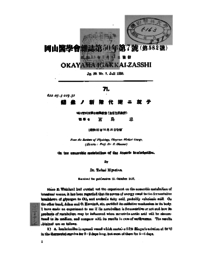

Journal of Okayama Medical Association
Published by Okayama Medical Association<Availability>
Full-text articles are available 3 years after publication.
Permalink : https://ousar.lib.okayama-u.ac.jp/44880
蛔蟲ノ新陳代謝ニ就テ
宮島 忠
岡山醫科大學生理學教室
発行日
1938-07-31
抄録
Since E. Weinland had carried out the experiment on the anaerobic metabolism of intestinal worms, it has been regarded that its source of energy owed to the fermentative breakdown of glycogen to CO2 and avolatile fatty acid, probably valerianic acid. On the other hand, Adam and O. Harnisch, etc. certified its oxidative mechanism in its body. I have made an experiment to see if its metabolism is fermentative or not and how its products of metabolism may be influenced when monoiodo-acetic acid will be circumfused in its medium, and compare with its results in case of earthworms. The results obtained are as follows. 1) A. lumbricoides in opened vessel which contains 0.9% Ringer's solution at 38°C in the thermostat survive for 2-9 days long, but most of them for 5-6 days. 2) In the vessel of same solution, shut from air, the Worms 2 hours later an average its oxygen intake is 0.060mg. by 1 hour and 1g., CO(2) output 0.312mg., and its respiratory quotient is 3.3. And 18-20 houurs later O(2) intake decreases to 0.0158mg. and CO(2). output 0.125mg. Its respiratory quotient is 5.9. 3) In the vessel which filled with 0.9% Ringer's solution made from underground water which contains about 3-4cc. of O(2) in 100cc., the worms could not longer survive than 4 days. The gasmetabolism in the vessel shows O(2) intake by 1 hour and 1g. 0.002mg. and its respiratory quotient 3.7. 4) Through the bubbling of H(2)-gas in this solution its O(2)-content was reduced to 1.062cc. per L., the worms output CO(2) extraordinary large in spite of its O(2)-intake 0.00176mg., its respiratory quotient 161. 5) In 0.01% M.I.A.-Ringer's solution the worms 2 hours later O(2)-intake 0.063mg., CO(2)-output 0.378 mg. and its respiratory quotient 3.6. 15-20hours later, its O(2)-intake and CO(2)-output reduced to 0.0074 and 0.087mg respectively. Its respiratory quotient 6.1. 6) When these results compared with those of earthworms, CO(2)-output is always greater than earthworms in spite of similar amounts of O(2)-intake. O(2)-intake does not influenced by M.L.A. From these facts, it seems the metabolism in anaerobic life of A. lumbricoides owes much more to fermentative breakdown of glycogen than in case of earthworms, by which oxidation plays some part of metabolism.
ISSN
0030-1558
NCID
AN00032489
